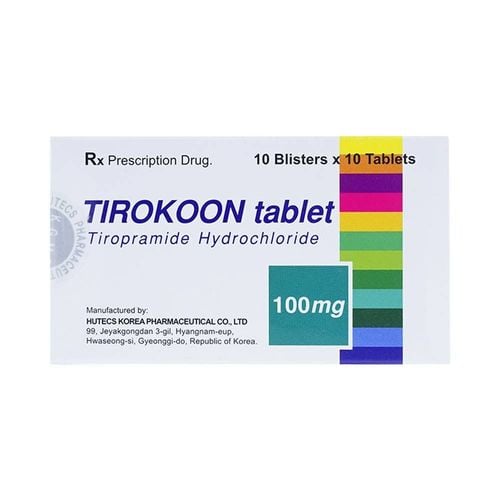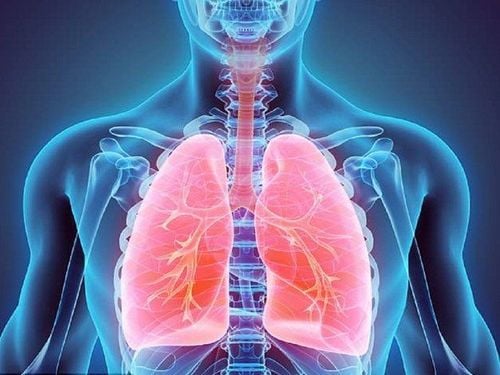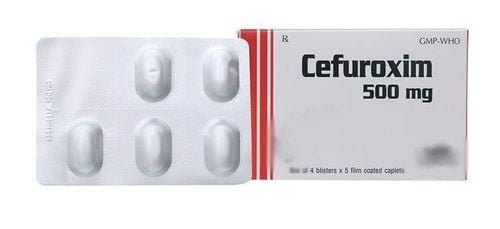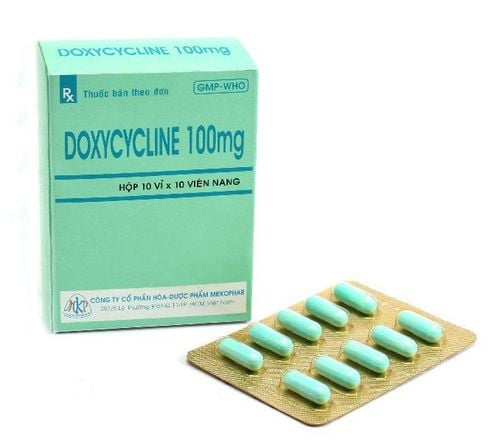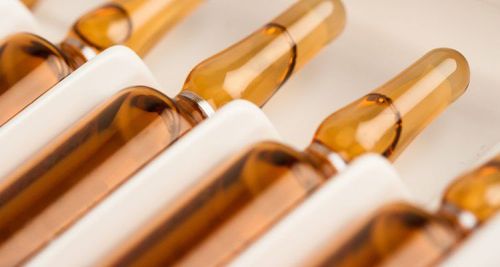This is an automatically translated article.
Kabatis is an oral antibiotic belonging to the first generation Cephalosporin group, with a broad spectrum of activity against gram-positive bacteria and less activity against gram-negative bacteria.
1. What is Kebatis?
Kebatis drug has the main ingredient is Cepharadin 250mg, which is prepared in the form of a powder package for oral mixing.
Cepharadin is a semi-synthetic, broad-spectrum, first-generation Cephalosporin antibiotic. The drug has a bactericidal effect, acting on both gram-positive and gram-negative bacteria. Like the penicillins, Cefradine has a bactericidal effect by inhibiting the synthesis of mucopeptides in the bacterial cell wall by acylation of transpeptidase enzymes that prevent the cross-linking of the peptidoglycan chains required for building build strength and stiffness of bacterial cell walls.
Antibacterial spectrum: Mainly active against Gram-positive bacteria: Staphylococcus aureus secreting or not secreting penicillinase, group A beta-hemolytic Streptococcus (Streptococcus pyogenes); group B Streptococcus (S. agalactiae) and Streptococcus pneumoniae. The effect of the drug is more limited in Gram-negative bacteria such as Escherichia coli, Klebsiella pneumoniae, Proteusmirabilis and Shigella.
2. Uses of the drug Kebatis
Kebatis medicine has the effect of killing bacteria, so it is indicated for the treatment of bacterial infections such as:
Bacterial infections of the skin and soft tissues such as impetigo, skin abscesses, cellulitis, boils. Upper respiratory tract infections such as rhinosinusitis, pharyngitis caused by group A beta-hemolytic streptococci, tonsillitis, croup, and even otitis media. Lower respiratory tract infections such as acute and chronic bronchitis, lobar pneumonia, bronchiolitis inflammation. Urinary tract infections such as cystitis, urethritis and pyelonephritis. Bone infections ; Prophylaxis in intraoperative infections and treatment with this drug should be continued in the postoperative period. Contraindications:
Kebatis should not be used in cases where the patient has a history of hypersensitivity to Cephradine and Cephalosporin antibiotics or excipients of the drug.
3. How to use and dose Kebatis
Usage:
The drug is taken orally, mix the powder pack with a sufficient amount of water, stir well and drink. Dosage:
Adults: The usual dose is 250 - 500mg x 4 times/day, or can take 500mg to 1g x 2 times/day. May be up to 4g/day orally. The maximum dose should not exceed 8g/day. Specifically:
Skin and soft tissue infections : Oral dose of 250mg x 4 times/day or 500mg x 2 times/day. Respiratory tract infections: Take 250mg and 4 times/day or 500mg x 2 times/day. Treatment of lobar pneumonia: Take 500mg x 4 times/day or take 1g x 2 times/day. Urinary tract infections: The usual dose is 500mg x 4 times a day or 1g x 2 times a day. The dose may be increased for more severe infections or chronic infections. Children: The usual dose is 25-100mg/kg/day, divided into 2-4 times. The maximum oral dose per day should not exceed 4g. Depending on each case of infection as follows:
Otitis media: Oral is usually used at a dose of 25-50mg/kg x 2-4 times/day. With otitis media caused by bacteria H. influenzae orally at a dose of 75-100mg/kg x 2 to 4 times/day. The effectiveness of the drug has not been fully tested in children under 9 months of age. Respiratory tract infections: The dose is 45mg/kg x 4 times/day. Use within 10 days to treat secondary pneumonia. Prophylaxis of pneumonia caused by Staphylococcus aureus for children from 7 to 18 years old with a dose of 2g x 2 times/day. Dose for patients with renal impairment: Initial dose is 750mg, maintenance doses are 500mg/time, dose interval varies depending on creatinine clearance.
Creatinine clearance > 20ml/min, the dosing interval is 6-12 hours. If creatinine clearance is > 19-15 ml/min, then the dosing interval is 12-24 hours. Creatinine clearance is 14-10ml/min and the dosing interval is 24-40 hours. Creatinine clearance from 9-5ml/min at intervals of 40-50 hours Creatinine clearance <5ml/min followed by dosing intervals of 50-70 hours. Hemodialysis: The starting dose is 250 mg administered at the start of dialysis. Then take a dose of 250mg x 3 times, each time 12 hours apart. Overdose and missed dose:
Overdose may occur with symptoms such as nausea, vomiting, stomach pain, loose stools. In case of overdose, supportive treatment is usually instituted, gastric lavage is recommended if a large amount has been ingested. Peritoneal dialysis or hemodialysis can be performed to lower blood levels of cefradine if necessary. Missed dose: If a dose is missed, take it as soon as possible. However, if it is almost time for your next dose, skip the missed dose and take your next dose at the scheduled time. Do not take twice the prescribed dose. Avoid missing doses as this reduces the effectiveness of the antibiotic and increases the risk of resistance.
4. Side effects of the drug Kebatis
Possible side effects when taking Kebatis, including:
Common: Hypersensitivity reactions such as fever, serum sickness-like reactions, anaphylaxis, skin rash, urticaria; eosinophilia; nausea, vomiting, diarrhea and pseudomembranous colitis; agranulocytosis, a complication that causes bleeding. Uncommon: Acute tubular necrosis after overdosage is often associated with the elderly, those with a history of renal failure or when co-administered with nephrotoxic drugs such as aminoglycoside antibiotics; acute interstitial nephritis. Rare: Hepatitis , cholestatic jaundice. Other side effects: Vaginitis, candidiasis, sleep disturbance, hyperactivity or confusion, dizziness, gingivitis, heartburn, toxic epidermal necrolysis, Stevens-Johnson syndrome, chest tightness, pain joints, edema. If you experience side effects of the drug, the patient should notify the doctor for appropriate advice and treatment.
5. Things to note when taking Kebatis
Before starting treatment with the antibiotic Cephradine, the patient's history of allergy to Cephalosporins and Penicillins must be carefully explored because of the risk of cross-allergic reactions. Prolonged use of antibiotics can lead to antibiotic resistance in bacteria and the development of non-susceptible bacteria. Take the medicine exactly as prescribed, do not increase or decrease the dose on your own, or stop taking it suddenly when symptoms are relieved, this increases the risk of side effects, antibiotic resistance. Renal function and blood must be monitored during long-term and high-dose treatment. Cefradine crosses the placenta very rapidly during pregnancy. Cephalosporins are generally considered a safe antibiotic when administered to pregnant women, but caution is still needed. Cefradine is also secreted into breast milk in low concentrations, but breast-feeding problems may occur, including changes in the gut microbiota, direct effects on the infant, and influence on the interpretation of culture results. when the child needs to be tested. Breastfeeding or drug should be stopped when the baby has diarrhea, skin rash or Candida infection. Interactions with other drugs: Loop diuretics when used concurrently may increase the nephrotoxicity of Cephalosporins; Probenecid increases serum concentrations of the active substance Cefradine; Cephradine may decrease the effectiveness of typhoid vaccine. Storage: Kebatis medicine should be stored in a cool place, away from direct light and out of reach of children. Do not use when the medicine has expired and shows signs of deterioration. Above is information about oral medicine Kebatic, patients need to carefully read the instructions for use, consult a doctor / pharmacist before using. Note, Kebatic is a prescription drug, so patients should absolutely not self-medicate at home because they may experience unwanted side effects.




